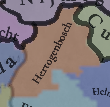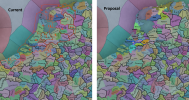Hello everybody, and welcome to the first post of Tinto Maps! This is a new weekly series that we will be running about the top-secret game Project Caesar.
Let me introduce myself before I continue, as some of you may get to know me from the development of the latest EUIV DLCs, but I might not be as well-known to everyone as Johan. I’m Pavía, the Content Design Lead at Paradox Tinto, which I joined in 2021. Before becoming a videogame developer, my background was as a Historian, which led me to work on a PhD. in Medieval History (fool me!), which I finished in 2020. Besides that, I’ve spent several thousands of hours of my life playing Paradox GSGs since I discovered and started playing Europa Universalis 20 years ago, in 2004.
What this new series will be about is quite straightforward: each week I will be sharing with you maps of a new different region, so you have an outlook of them and we are able to receive early feedback (because as you may already know from Johan’s Tinto Talks, there is still a lot of WIP stuff ongoing).
About this feedback, we’d like you to take into account a couple of things. The first is that we’ve worked really hard to gather the best sources of information available to craft the best possible map; we used GIS tools with several layers of historical map sources from academic works, geographical data, administrative data, etc., to help us ensure the desired quality. So we would appreciate getting specific suggestions backed by these types of sources, as others (let’s say, a Wikipedia map or YouTube video with no references) may not be reliable enough. The second thing to comment on is that sometimes a certain decision we made was an interpretation over an unclear source, while sometimes we have just plainly made some errors when crafting the map (which on a 30,000 location map is a normal thing, I guess). I’ll let you know when any of these happen, and I’m also going to ask for your understanding when an error or bug is found and confirmed as such.
With those forewords said, let’s start with today’s region: the Low Countries! This is what the political map looks like:

The regional situation in 1337. The counties of Hainaut, Holland, and Zeeland are ruled by William of Avesnes, who is married to Joanna, daughter of Duke John III of Brabant. Another John, the Duke of Luxembourg, might be the strongest power, as he is also the King of Bohemia. The County of Flanders is the wealthiest country in the region, controlling such important cities as Brugge and Ghent. Up in the north, we have other interesting countries, such as the Bishopric of Utrecht or the Republic of Frisia (you might notice that we're using a dynamic custom country name for them, 'Frisian Freedom').
And here we have the locations:

We had a fun bug for some time - Antwerpen didn’t have any pixels connected to the sea, which we found because we couldn’t build any type of port building there. There’s a happy ending, as the bug has already been corrected, and Antwerpen can finally have a proper port!
Provinces:

Terrain (Climate, Topography, and Vegetation):



We are aware that the Netherlands looked differently in the 14th century, as several land reclamations took place during the Late Medieval and Early Modern periods, but we are using a 20th-century version of the map for the sake of consistency. Most of the regions throughout the world would look quite different from nowadays, and documenting those changes (especially the coastline shapes) would be a non-trivial problem to resolve. As a side note, we already removed Flevoland from it, and have already identified some other modern ones that slipped through and we'll eventually remove them, as well.
Cultures:

The stripes mean that there are pops of different culture inhabiting in those location. Also, the German and French cultures are WIP, we’ll show you a proper version on later Tinto Maps.
Religions:

Not many religions here yet, although there will be interesting religious stuff happening eventually…
Raw Goods:

Goods get regularly swapped around here and there to have a balance between geographical and historical accuracy, and gameplay purposes. So take this as the far-from-final current version of them.
And an additional map for this week:

We reinstated a Low Countries market centered on Antwerpen, after doing some balance tweaks that made it more viable.
And these are the maps for today! I hope that you have a nice weekend, and next Friday, we will travel down south, to Iberia!
Let me introduce myself before I continue, as some of you may get to know me from the development of the latest EUIV DLCs, but I might not be as well-known to everyone as Johan. I’m Pavía, the Content Design Lead at Paradox Tinto, which I joined in 2021. Before becoming a videogame developer, my background was as a Historian, which led me to work on a PhD. in Medieval History (fool me!), which I finished in 2020. Besides that, I’ve spent several thousands of hours of my life playing Paradox GSGs since I discovered and started playing Europa Universalis 20 years ago, in 2004.
What this new series will be about is quite straightforward: each week I will be sharing with you maps of a new different region, so you have an outlook of them and we are able to receive early feedback (because as you may already know from Johan’s Tinto Talks, there is still a lot of WIP stuff ongoing).
About this feedback, we’d like you to take into account a couple of things. The first is that we’ve worked really hard to gather the best sources of information available to craft the best possible map; we used GIS tools with several layers of historical map sources from academic works, geographical data, administrative data, etc., to help us ensure the desired quality. So we would appreciate getting specific suggestions backed by these types of sources, as others (let’s say, a Wikipedia map or YouTube video with no references) may not be reliable enough. The second thing to comment on is that sometimes a certain decision we made was an interpretation over an unclear source, while sometimes we have just plainly made some errors when crafting the map (which on a 30,000 location map is a normal thing, I guess). I’ll let you know when any of these happen, and I’m also going to ask for your understanding when an error or bug is found and confirmed as such.
With those forewords said, let’s start with today’s region: the Low Countries! This is what the political map looks like:

The regional situation in 1337. The counties of Hainaut, Holland, and Zeeland are ruled by William of Avesnes, who is married to Joanna, daughter of Duke John III of Brabant. Another John, the Duke of Luxembourg, might be the strongest power, as he is also the King of Bohemia. The County of Flanders is the wealthiest country in the region, controlling such important cities as Brugge and Ghent. Up in the north, we have other interesting countries, such as the Bishopric of Utrecht or the Republic of Frisia (you might notice that we're using a dynamic custom country name for them, 'Frisian Freedom').
And here we have the locations:

We had a fun bug for some time - Antwerpen didn’t have any pixels connected to the sea, which we found because we couldn’t build any type of port building there. There’s a happy ending, as the bug has already been corrected, and Antwerpen can finally have a proper port!
Provinces:

Terrain (Climate, Topography, and Vegetation):



We are aware that the Netherlands looked differently in the 14th century, as several land reclamations took place during the Late Medieval and Early Modern periods, but we are using a 20th-century version of the map for the sake of consistency. Most of the regions throughout the world would look quite different from nowadays, and documenting those changes (especially the coastline shapes) would be a non-trivial problem to resolve. As a side note, we already removed Flevoland from it, and have already identified some other modern ones that slipped through and we'll eventually remove them, as well.
Cultures:

The stripes mean that there are pops of different culture inhabiting in those location. Also, the German and French cultures are WIP, we’ll show you a proper version on later Tinto Maps.
Religions:

Not many religions here yet, although there will be interesting religious stuff happening eventually…
Raw Goods:

Goods get regularly swapped around here and there to have a balance between geographical and historical accuracy, and gameplay purposes. So take this as the far-from-final current version of them.
And an additional map for this week:

We reinstated a Low Countries market centered on Antwerpen, after doing some balance tweaks that made it more viable.
And these are the maps for today! I hope that you have a nice weekend, and next Friday, we will travel down south, to Iberia!








